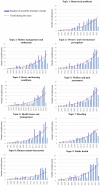Cats' and dogs' welfare: text mining and topics modeling analysis of the scientific literature
- PMID: 37901113
- PMCID: PMC10601470
- DOI: 10.3389/fvets.2023.1268821
Cats' and dogs' welfare: text mining and topics modeling analysis of the scientific literature
Abstract
Animal welfare is a field with increasing significance and has been raising huge concerns of the public and the political stage. Cats and dogs possess an important role in human life, but their welfare is not always secured from a legal aspect. This review aimed to describe the evolution and geographical distribution of "cats and dogs" and "puppies and kittens" welfare literature over the last 40 years, distinguish the main research topics studied and highlight gaps in knowledge. A search using Scopus® was performed with different search strings and predetermined filters as time range, language, and subject area. A total of 2,725 scientific literature records were retrieved but only the ones that referred to cats and dogs' welfare aspects were retained. The final 1,775 records were processed through descriptive statistics, and text mining and topic analysis procedures were performed on their titles and abstracts. The results showed that the number of studies has been increasing, especially in Europe and North America. "Shelter" was the most frequent word, followed by "behavior," "owner" and "adopt." The nine topics that emerged from the analysis were breeding, stress and housing conditions, welfare and pain assessment, public health, shelter management and euthanasia, behavioral problems, health issues and management, human-animal interaction, and owners' and veterinarians' perceptions. While stress and housing conditions, public health, and owners' and veterinarians' perceptions were the most studied topics, human-animal interaction was the least studied. This review confirmed the increasing research and interest in cats' and dogs' welfare and showed gaps in knowledge where further studies are needed.
Keywords: behavior; canine; companion animals; feline; machine learning; systematic review; well-being.
Copyright © 2023 Adamaκopoulou, Benedetti, Zappaterra, Felici, Masebo, Previti, Passantino and Padalino.
Conflict of interest statement
The authors declare that the research was conducted in the absence of any commercial or financial relationships that could be construed as a potential conflict of interest. The author(s) declared that they were an editorial board member of Frontiers, at the time of submission. This had no impact on the peer review process and the final decision.
Figures








References
-
- Fraser D, Weary DM, Pajor EA, Milligan BN. A scientific conception of animal welfare that reflects ethical concerns. Anim Welf. (1997) 6:187–205. doi: 10.1017/S0962728600019795 - DOI
-
- Broom D. Coping, stress and welfare In: Broom DM, editor. Coping with challenge: welfare in animals including humans. Berlin: Dahlem University Press; (2001). 1–9.
Publication types
LinkOut - more resources
Full Text Sources
Miscellaneous

